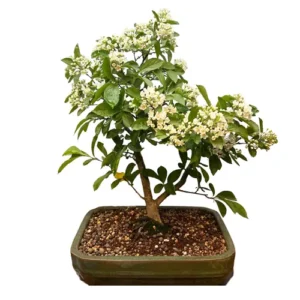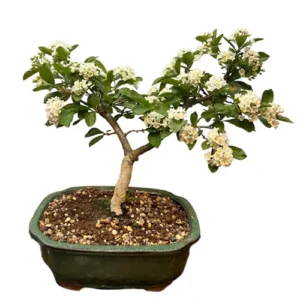Vitis vinifera
Grapevine Bonsai
Native to the Mediterranean and much of Central Europe, these deciduous shrubs grow large palmate leaves that glow green in summer before turning yellow, orange and red in the autumn. Older species that have been pruned back consistently make for brilliant bonsai. The fast growth of Grapevine makes them an inspired hobbyist choice.
Grapevine Bonsai Care Tips
Placement
Preferring the most Mediterranean of environments, Grapevine requires a lot of full sunlight. Across the growing season, they demand 8 hours or more of sunlight. Do not let the leaves scorch if the sun gets considerably hot, shade is advised. While moderately hardy, wet conditions and solid frost will kill a grapevine bonsai. For the UK, this plant can be grown indoors but replicating the light and warmth of a Mediterranean-esque climate is required.
Watering
Thanks to its considerable growth rate, Grapevine bonsai demands a lot of water to keep its leaves soli and the fruit swelling. Stay watchful of the soil moisture allowing it to dry out between waterings but ensure it never dries out completely.
Feeding & Fertilising
During the growing season, once the fruit has set, feed your Grapevine Bonsai once with a low-nitrogen fertiliser. Any feeding beforehand will spoil the fruit growth.
Pruning & Wiring
Two or three buds should be pruned back in the late summer to encourage fruiting next year. Any young tendrils should be pinched back in the summer. Do not do any robust pruning in the winter.
Any shaping can be done through pruning, but using wires should be done in the mid-summer. We recommend using wires with a thickness that matches the thickness of the branch: if the wire you choose is too thick you will damage the bark. If it is too thin, it won’t be effective.
Repotting
Repot your Grapevine bonsai every 2-3 years in the spring.
Trees that are ready for repotting will require root pruning, a suitable new pot and appropriate soil mix.
When repotting, do not cut back the root mass by a large amount, and choose a well-draining soil mix that has a neutral or slightly higher PH value of 5-6 but not over 7. We tend to use a mixture of different speciality bonsai soils on our trees. Every species is different so please contact us for free soil-mix advice or to take advantage of our repotting service.
Bonsai trees aren’t only magnificent additions to an indoor oasis, they are more than capable of standing out in any garden. Many Bonsai species are incredibly hardy and withstand nature’s colder and damper turns with aplomb making them worthwhile outdoor plants. We have an extensive library of care guides for outdoor bonsai trees. It’s not about selecting the perfect bonsai, it’s about selecting the perfect bonsai for you.
Grapevine Bonsai - Typical Queries
Can you propagate Grapevine bonsai?
Grapevine has proven a popular bonsai for hobbyists due to the ease at which it can be propagated. Cuttings and old vine stumps make for easy propagation with this species.
Do Grapevine bonsai attract pests and diseases?
Grapevine can attract both scale insects and aphids. This species can also incur mildew.
Is Grapevine a good beginner bonsai?
This is a relatively high-maintenance plant. They demand a lot of repotting and frequent input as they are a fast-growing species. This may not be the best plant for beginners, despite the promise of their delectable fruit.





















